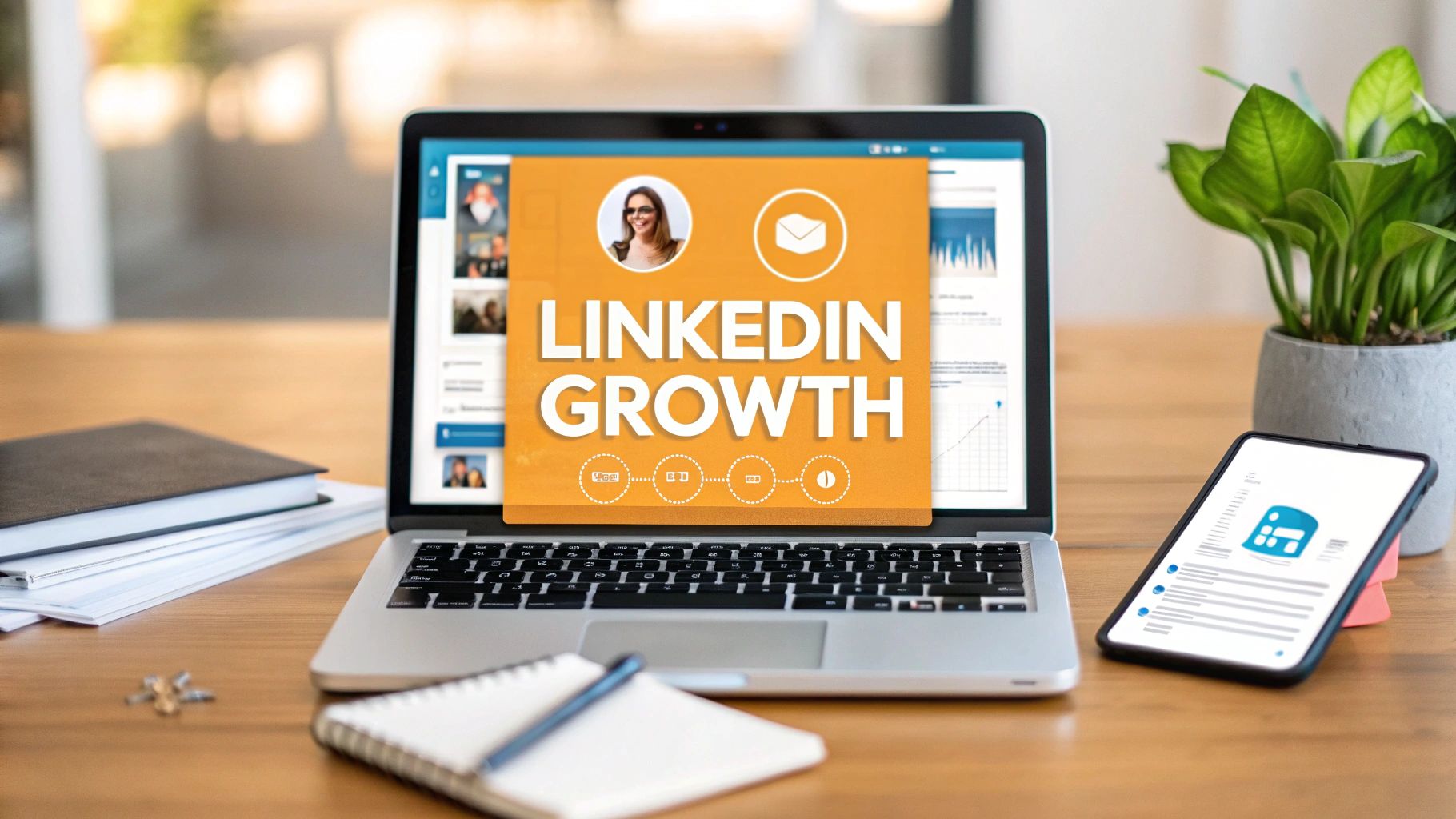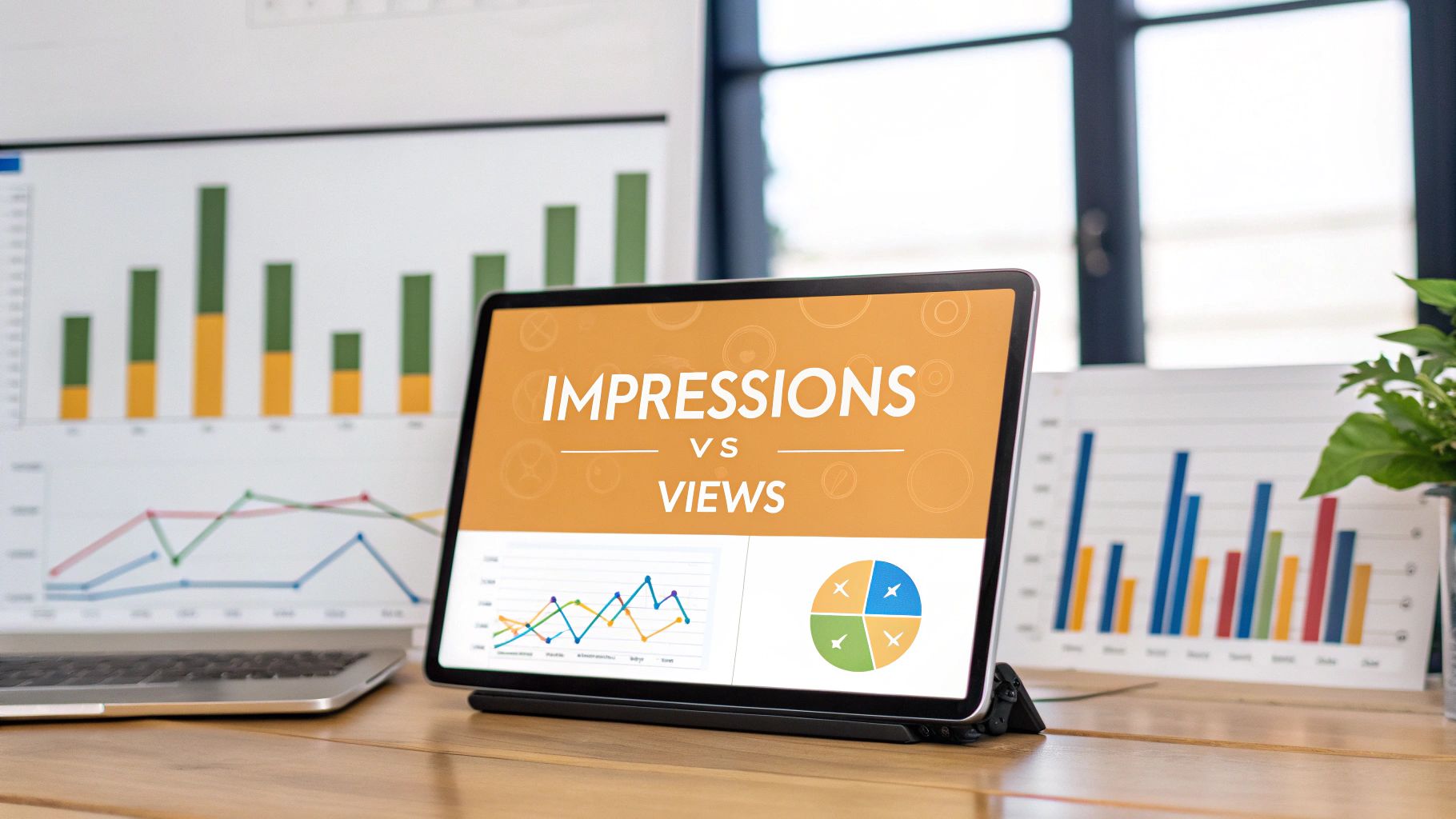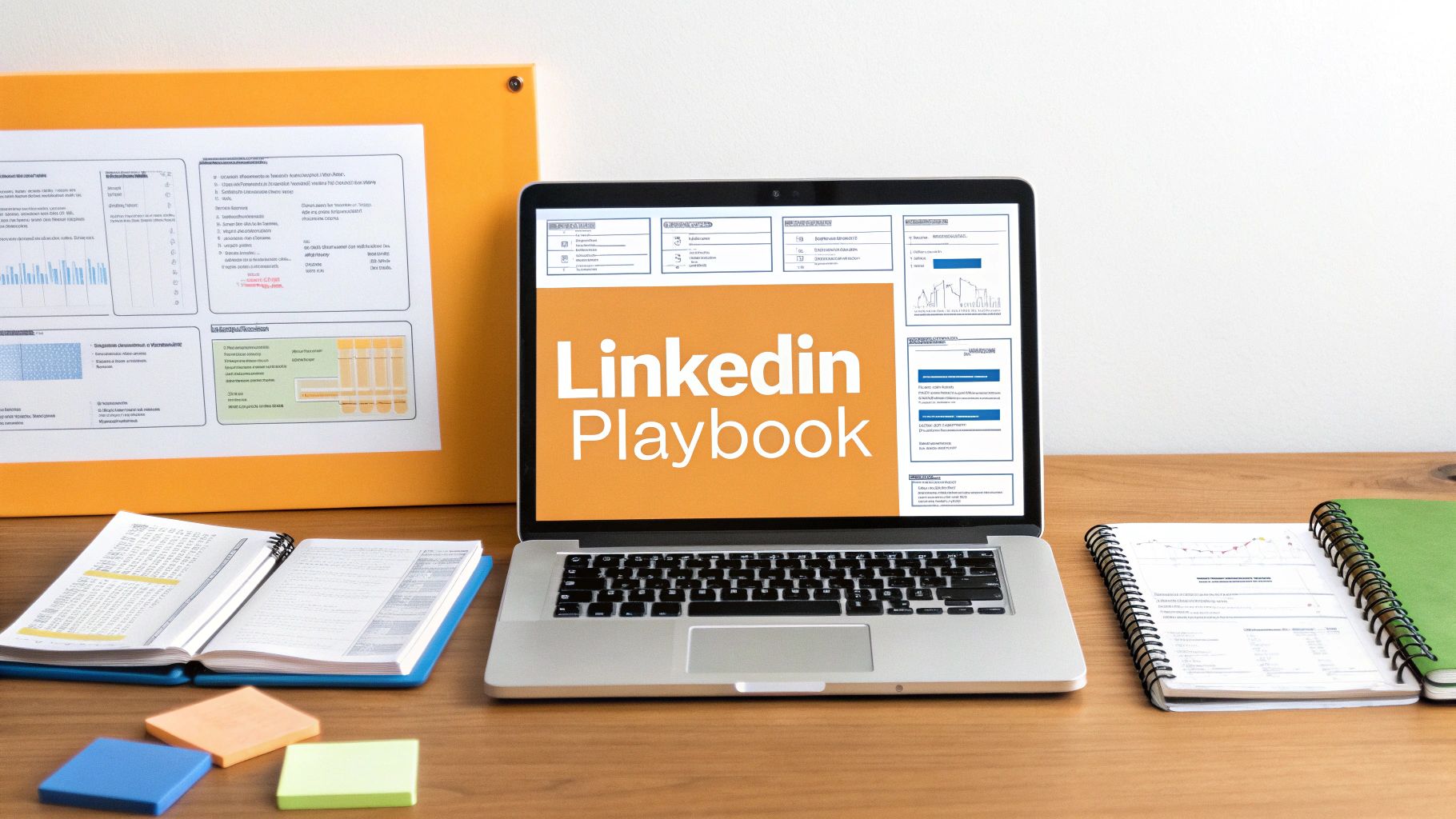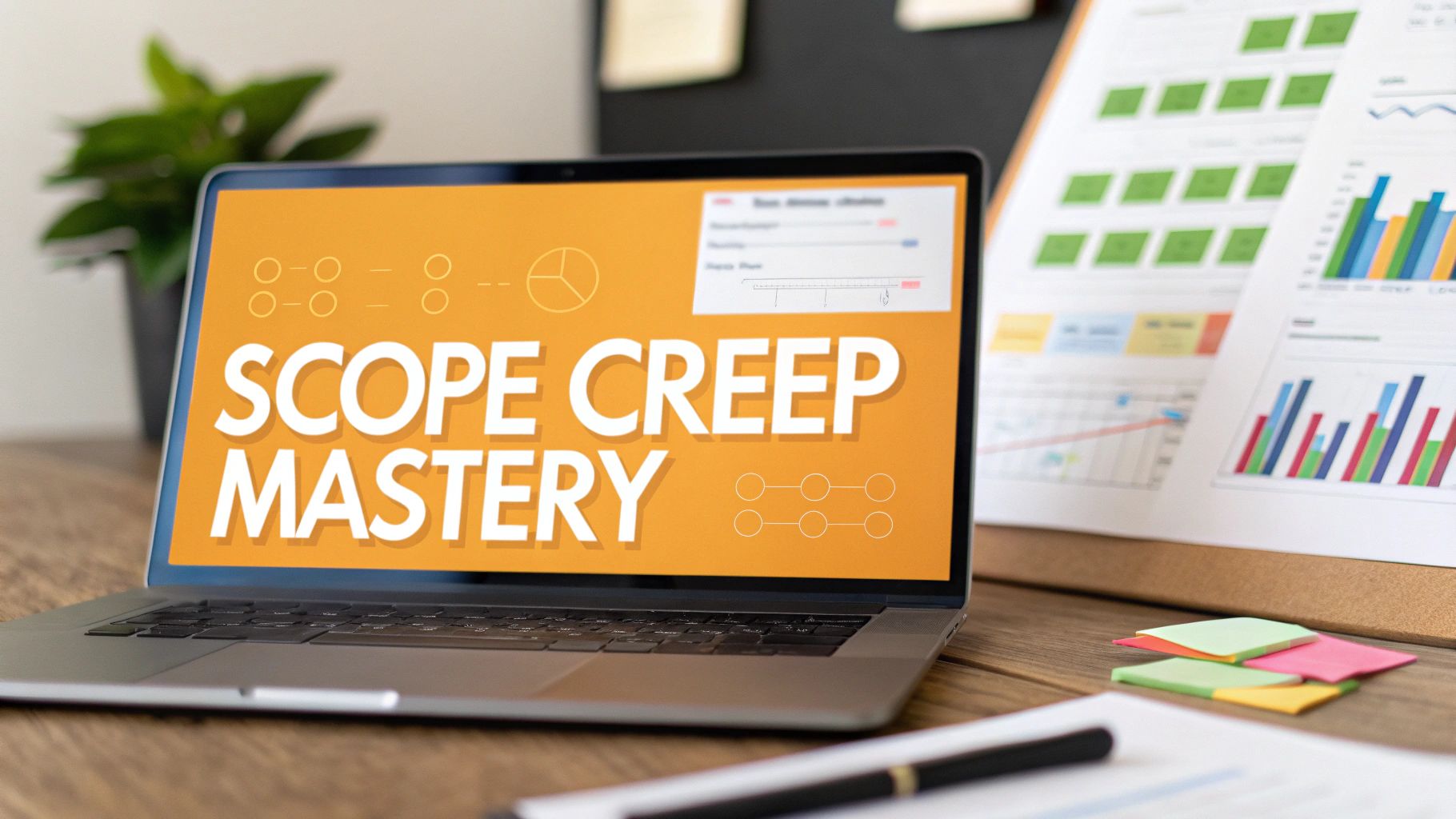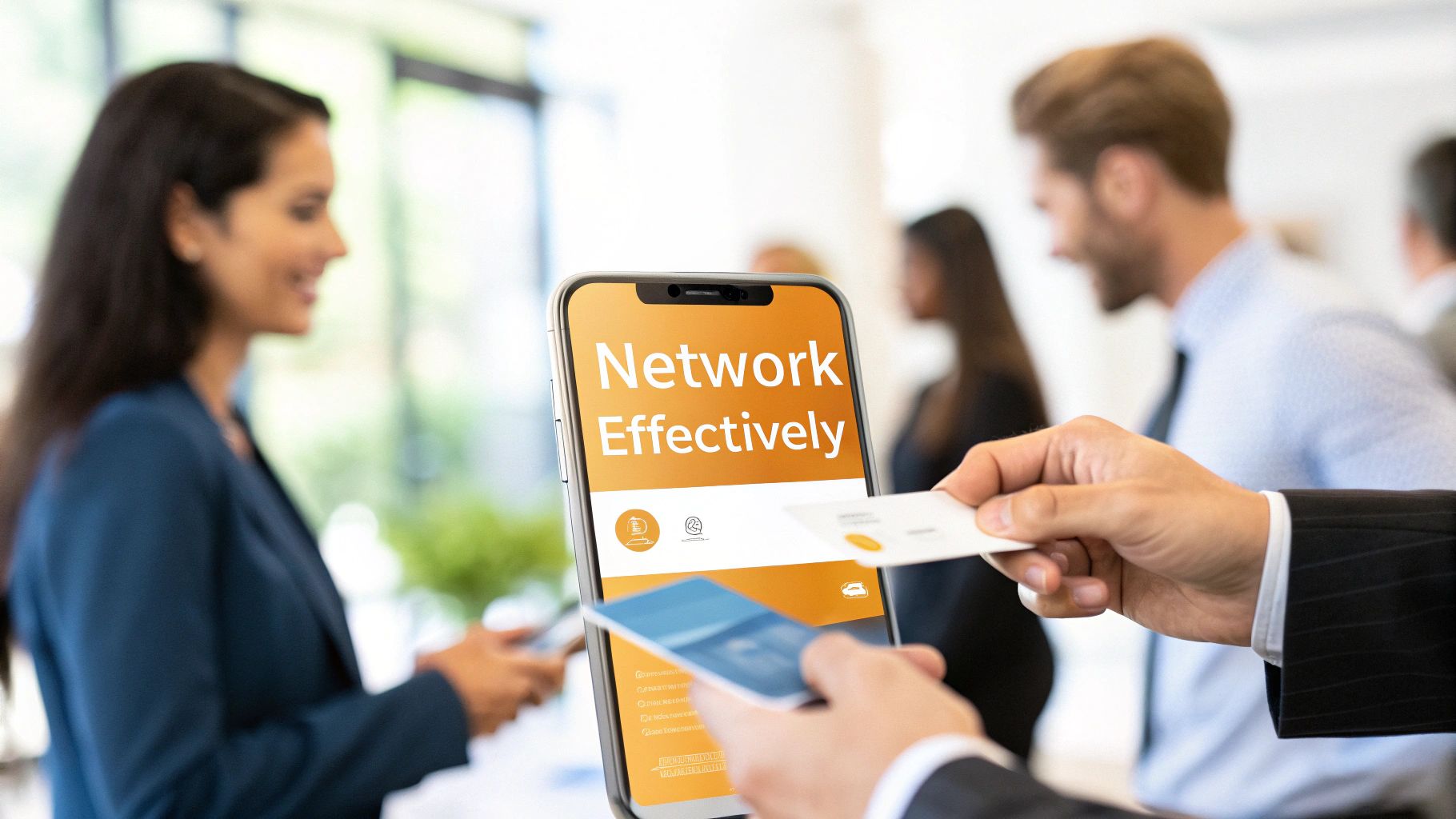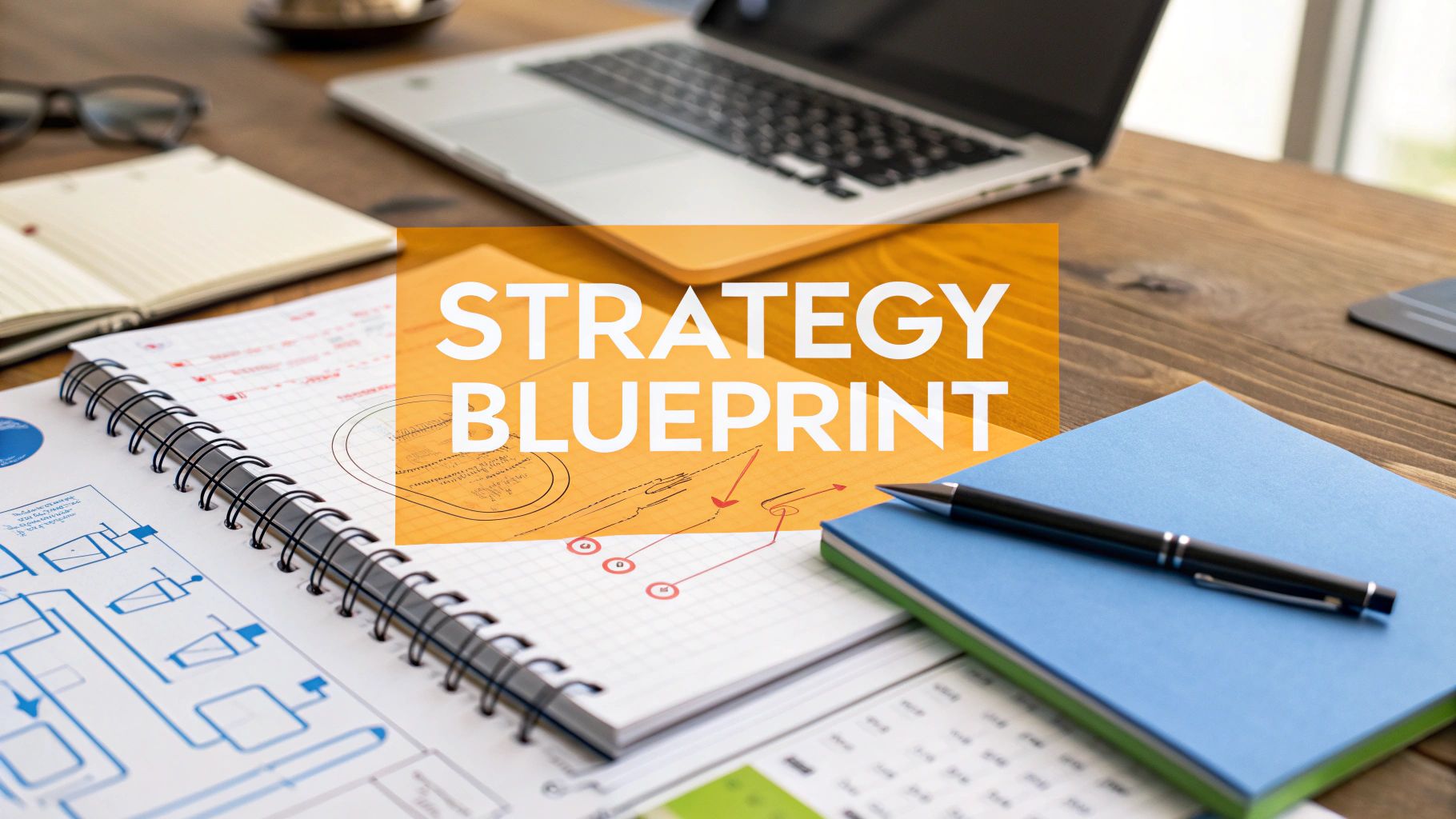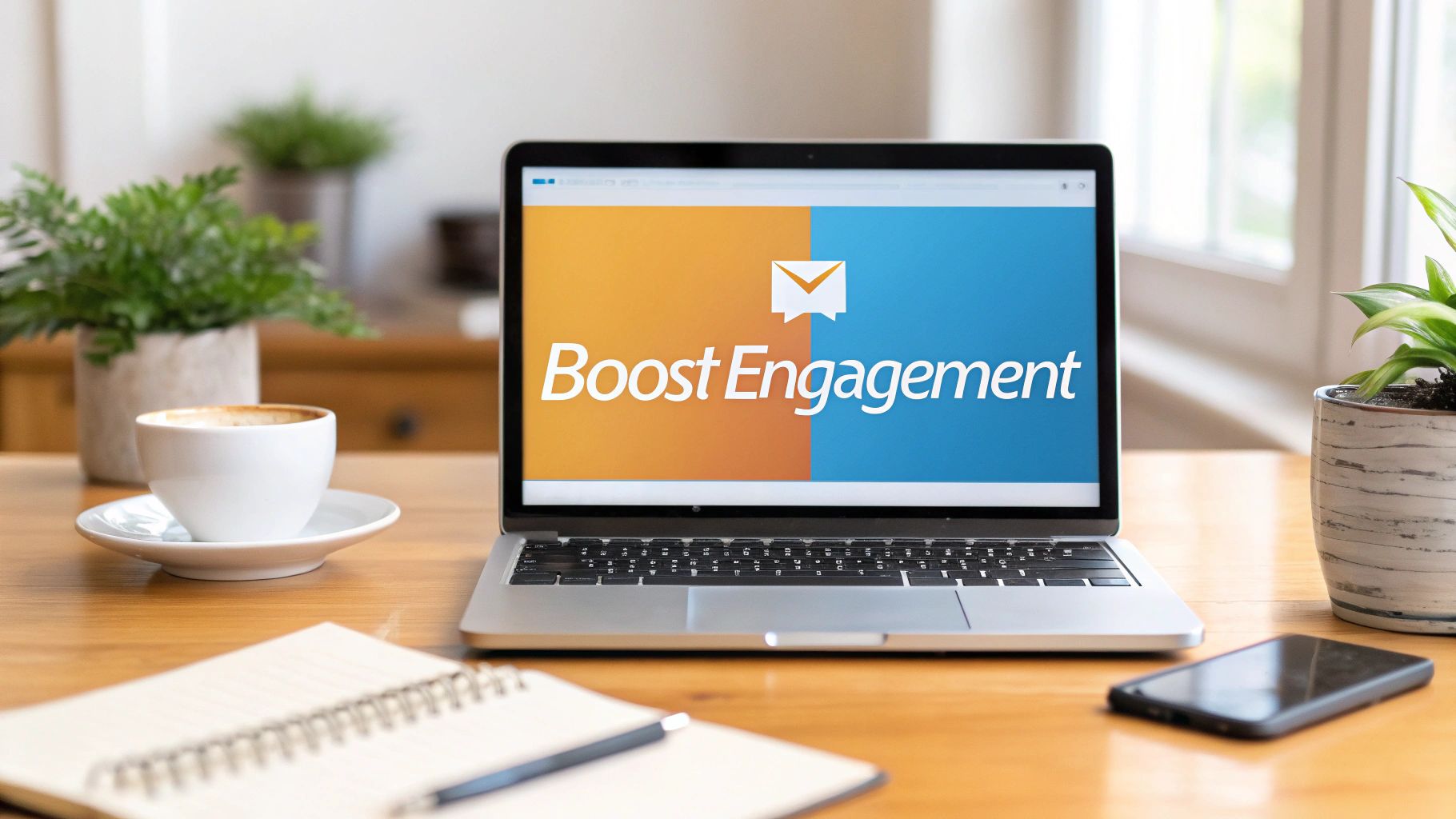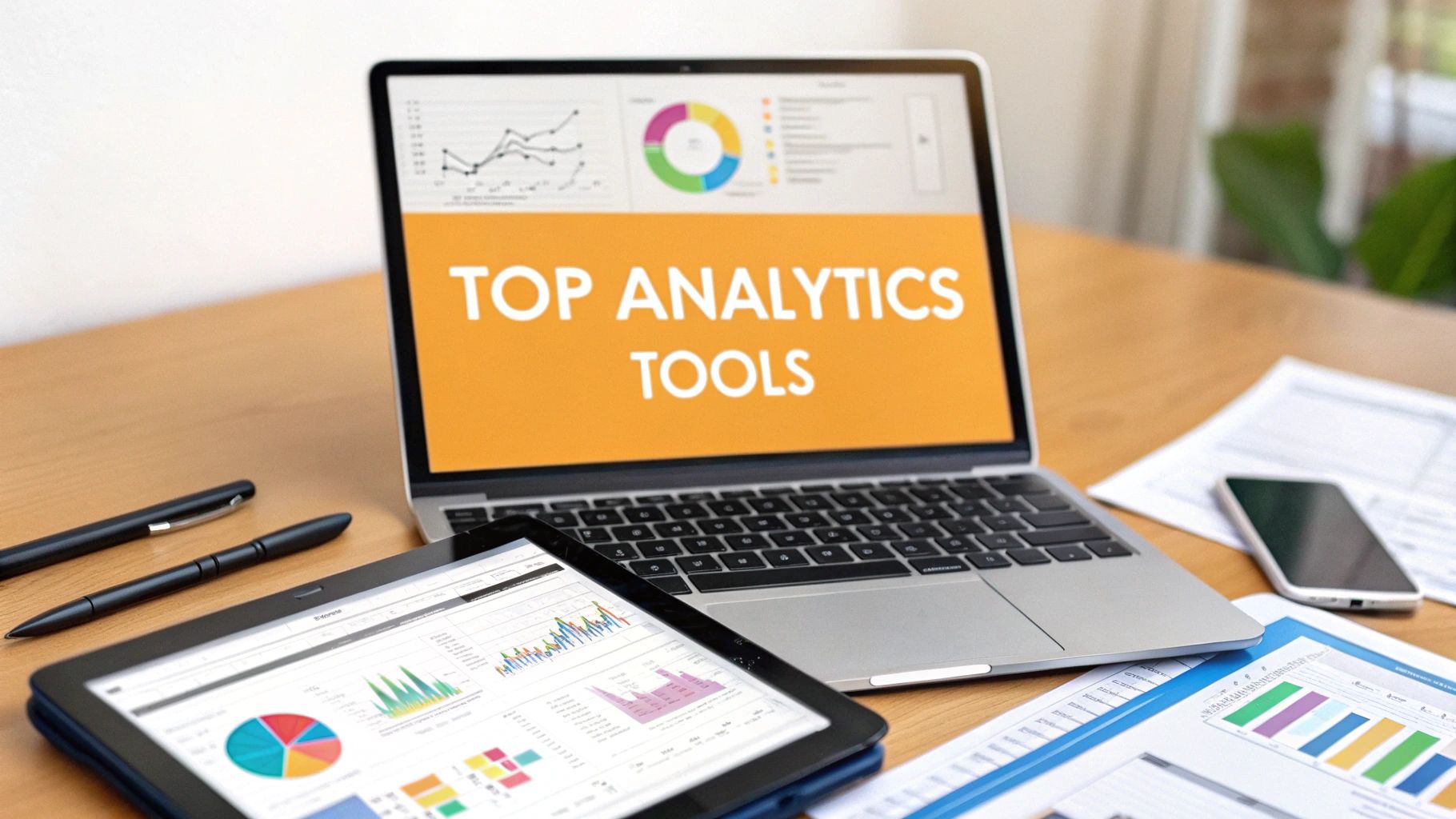Let's be honest, "Customer Relationship Management" sounds a little... corporate and stuffy. But don't let the name fool you. At its core, CRM is simply a way to manage every single interaction you have with the people who keep your business alive: your customers and potential customers.
The goal is refreshingly simple: make your business relationships better so your business can grow. A good CRM system is the tool that helps you stay connected, keep things organized, and ultimately, boost your bottom line.
What Is CRM and Why Should You Care?
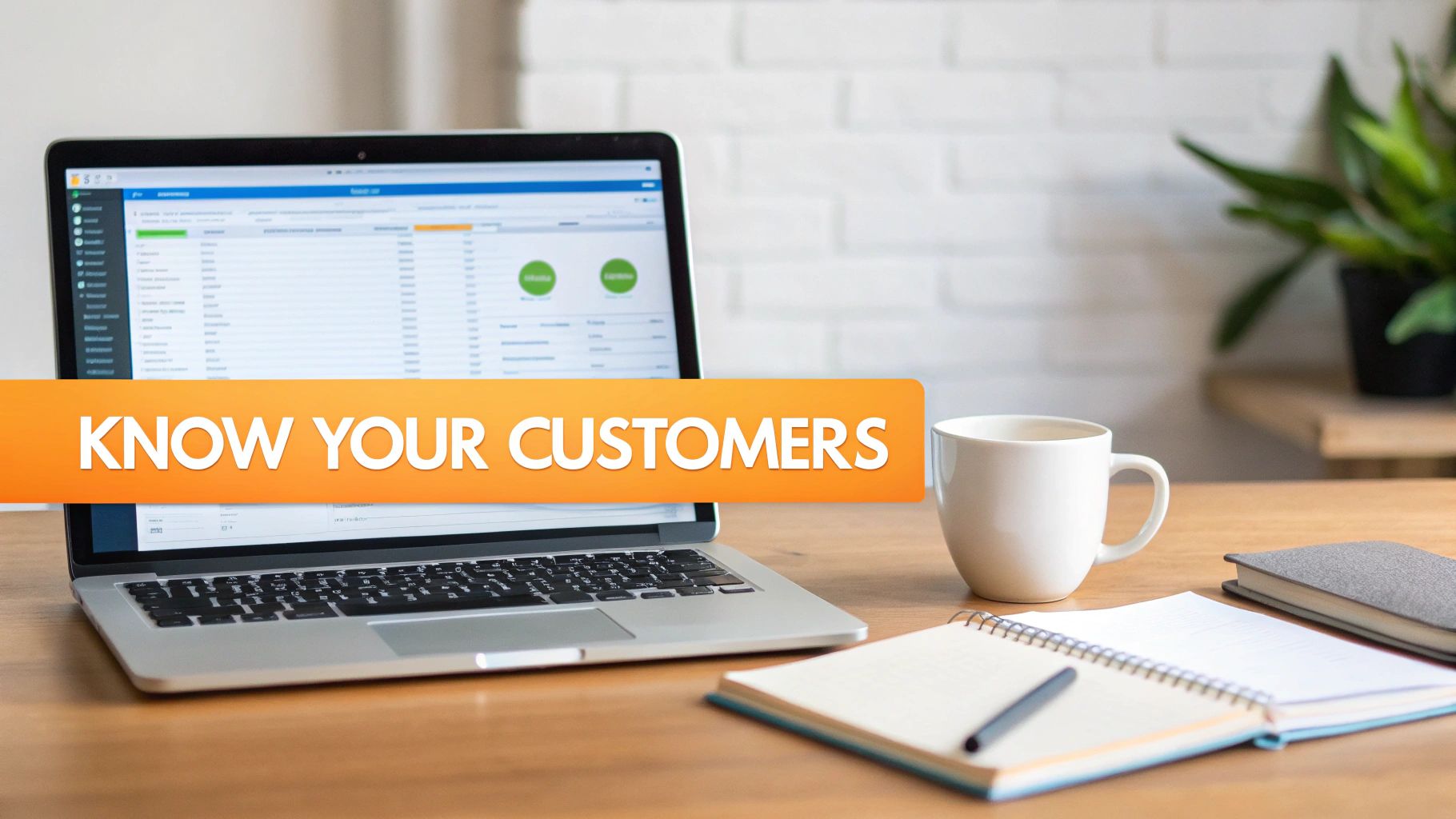
Forget the textbook definitions for a minute.
Think of a CRM as the central nervous system for your business. It's the one place that remembers every conversation, every purchase, and every little detail about your customers. It’s way more than a digital address book; it’s the strategy and the tech that lets you shift from one-off sales to building real, lasting connections.
And this isn't just some passing fad. The proof is in the numbers. Back in 2010, the global CRM market was worth around $14 billion. Fast forward to 2020, and that figure skyrocketed to about $69 billion—a massive jump of nearly 393%. That kind of growth tells you everything you need to know about how vital customer relationships have become.
The Problem With Sticky Notes and Spreadsheets
Look, we've all been there. When you're just starting out, a spreadsheet or a collection of notebooks seems like enough to track your customers. It works... until it doesn't.
As you grow, that manual system starts to crack. Details slip through the gaps, you forget to follow up, and different team members have different (and often outdated) information. It becomes impossible to give customers a consistent, high-quality experience.
This is where a CRM system steps in. It acts as the "single source of truth" for everything customer-related. Everyone on your team—from sales to marketing to support—gets the same 360-degree view of every customer. This shared knowledge is a game-changer for improving your team's relationship-building skills because everyone is working from the same playbook.
A CRM system gives every customer-facing employee the same script. Whether they're in sales, marketing, or customer service, they see the same history and data, which leads to a seamless, intelligent customer experience. Every interaction feels personal and informed.
What A CRM Really Does
A CRM system isn't just a database; it’s an active tool that helps you work smarter. Let's break down some of the core functions into plain English.
Core CRM Functions at a Glance
| Core Function | What It Really Means | Why It Matters |
|---|---|---|
| Contact Management | Storing customer info—names, emails, phone numbers, and conversation history. | No more hunting through spreadsheets. All the key details are in one clean, organized place. |
| Lead Management | Tracking potential customers from their first "hello" to the final sale. | It shows you exactly where every prospect is in your sales pipeline so you can follow up at the perfect time. |
| Sales Automation | Handling repetitive tasks like sending follow-up emails or scheduling meetings automatically. | Your sales team spends less time on admin work and more time actually talking to people and closing deals. |
| Marketing Automation | Sending targeted email campaigns and tracking how people engage with them. | You can send the right message to the right person without lifting a finger, nurturing leads until they're ready to buy. |
| Customer Service & Support | Managing support tickets and tracking customer issues from start to finish. | Nothing gets lost. You can solve problems faster, keeping customers happy and loyal. |
These functions all work together to paint a complete picture of your customer's journey, making your team more effective and your customers feel more valued.
It’s All About the Relationship
At the end of the day, using a CRM is about acknowledging a simple truth: your customers are your most valuable asset. A strong relationship builds loyalty, stops customers from jumping to a competitor, and can even turn your biggest fans into your best salespeople.
By putting all your customer data in one place and automating the busywork, a CRM helps you:
- Actually understand your customers: Look back at their purchase history and past conversations to figure out what they really want.
- Make every interaction personal: Use what you know to tailor marketing messages and product suggestions that feel genuine, not generic.
- Work more efficiently: Automate the mundane tasks so your team can focus on what humans do best—connecting with other humans.
From a one-person shop to a massive enterprise, the goal is the same. A CRM is the foundation for finding, winning, and keeping customers for the long haul.
The Three Pillars of a Winning CRM Strategy
Putting a powerful CRM in place without a strategy is like handing over the keys to a brand-new race car to someone who can't drive. The machine is impressive, sure, but it’s not going to get you across the finish line. Real success with CRM boils down to three pillars that have to work together perfectly.
Those three pillars are Technology, Processes, and People. If one is weak, the whole structure gets wobbly. But when all three are solid, you’ve built a powerful foundation for creating profitable, long-lasting customer relationships.
Pillar 1: Technology — The Engine of Your Strategy
First up is the CRM software itself. This is your digital command center, the central hub where all your customer data and interactions live. It’s the engine that drives your entire customer strategy, but just having the tech isn't enough.
The real trick is picking the right tool with features that actually line up with your business goals. For one company, that might mean top-notch sales automation to speed up the sales cycle. For another, it could be all about advanced marketing analytics to finally understand what makes customers tick.
Your CRM should feel less like a stuffy, rigid database and more like an intelligent assistant—something that simplifies tasks and gives you clear insights. Its main job is to make the other two pillars, your Processes and People, way more effective.
Pillar 2: Processes — Your Repeatable Playbook
Processes are the specific, repeatable steps your team follows to keep things consistent and the data clean. Think of them as the official playbook that shows everyone how to use the CRM technology. Without clear processes, even the best software quickly turns into a chaotic mess of duplicate contacts and outdated information.
Having a set playbook is crucial for a few big reasons:
- Keeps Your Data Clean: Processes dictate how a new contact gets added, how a lead’s status is updated, and when a deal is officially marked "closed." This is how you avoid the classic "garbage in, garbage out" problem that tanks so many CRM initiatives.
- Gets Everyone on the Same Page: When the whole team follows the same steps for logging a support ticket or qualifying a lead, nothing falls through the cracks. This is a huge part of achieving real B2B sales and marketing alignment, making sure everyone is working together.
- Helps You Scale: Solid processes mean you can grow your team without everything falling apart. New hires can get up to speed on a proven system, ensuring every customer gets the same great experience from day one.
A super simple example? A process for following up with new leads. It might be as straightforward as: every new lead gets a personalized email within 24 hours, followed by a phone call within three business days. This simple rule, when everyone follows it, guarantees no potential customer ever gets ignored.
A CRM strategy without clear processes is like a library with no cataloging system. You have all the information, but finding what you need is nearly impossible, making the entire resource ineffective.
Pillar 3: People — The Heart of Your CRM Success
At the end of the day, the most important pillar is your people. A CRM is just a tool; it's the team using it that actually brings the strategy to life. If your employees don't see the point or feel like it just adds more work to their plate, they won't use it. Plain and simple. Your investment will go right down the drain.
Getting this pillar right is about much more than a quick training session. It’s about building a company culture that is genuinely focused on the customer.
Here’s what it looks like when you get the "people" part right:
- Get Your Team On Board: Don't just tell them what to do—explain why you're bringing in a CRM. Show them how it’s going to make their jobs easier, help them crush their goals, and ultimately lead to happier customers.
- Train Them for the Real World: Go beyond the basic "click here" instructions. Show your team exactly how the CRM fits into their day-to-day work and helps them better understand the people they're talking to. To go deeper on this, check out our guide on how to create buyer personas—a perfect profile to manage inside your CRM.
- Build a Customer-First Mindset: Encourage everyone to use the insights from the CRM to personalize conversations and get ahead of customer needs. The goal isn't just to log data; it's to make every single customer feel seen and understood. That's a human touch, supercharged by technology.
What Are the Core Parts of a CRM System?
Think of a great CRM system like the engine of a high-performance car. It's not just one big part; it's a collection of essential components working in perfect harmony to drive your business forward. While every CRM platform has its own bells and whistles, they all share a few fundamental pieces that power your customer relationships.
Ultimately, a successful CRM isn't just about the software. It’s a mix of the right tech, smart processes, and a team that’s ready to use it.
This infographic breaks down how these three elements—technology, processes, and people—have to click together to create a winning strategy.
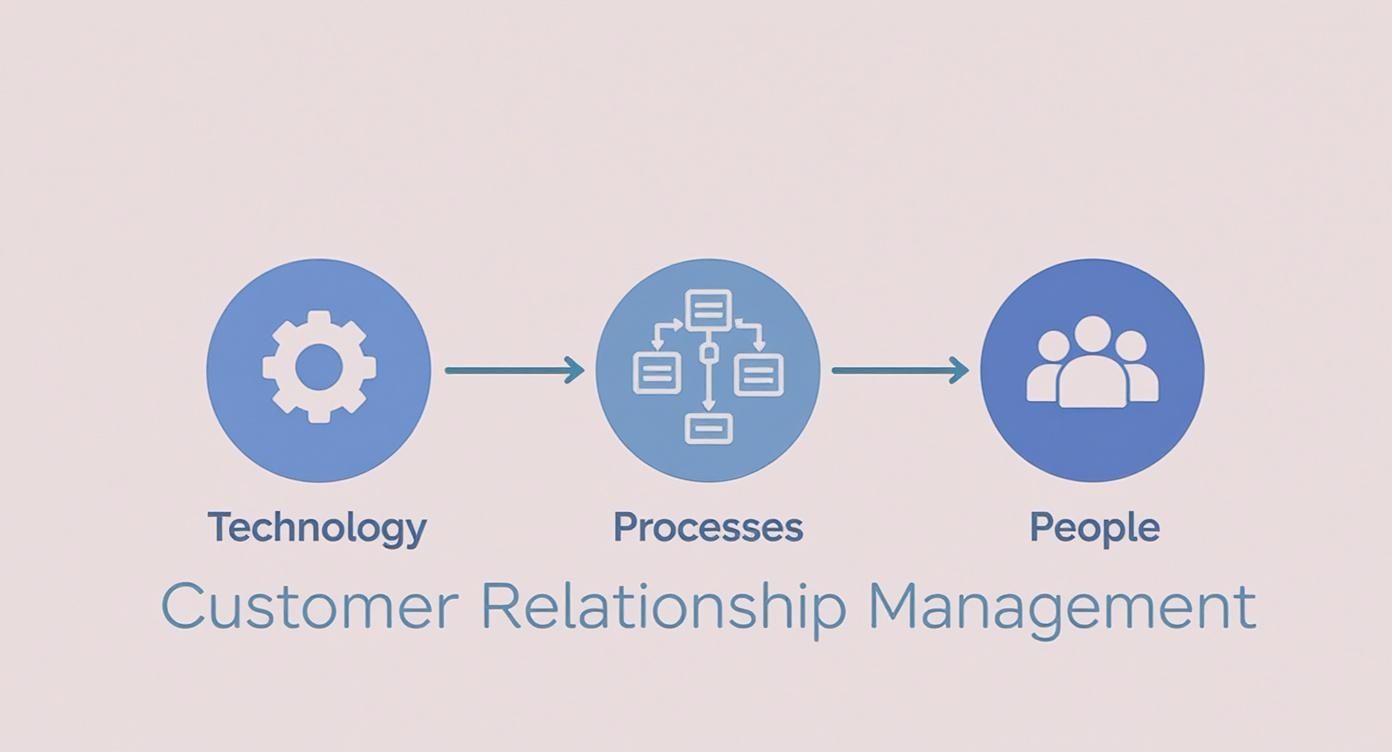
As you can see, the software is just the start. You need clear rules for how to use it and a team that’s trained and genuinely bought into the system.
With that in mind, let’s pop the hood and look at the key tech components that make it all run.
Contact Management: The Heartbeat of Your CRM
If a CRM is the engine, then contact management is the chassis—the solid foundation everything else is built on. This is so much more than a glorified digital address book. It's a living, breathing database that holds every key detail about your customers and prospects.
This includes things like:
- The Basics: Names, emails, phone numbers, company info, and job titles.
- Interaction History: A running log of every call, email, meeting, and support ticket.
- Social Media Profiles: Quick links to their professional profiles to get a better sense of who they are.
Having this 360-degree view means anyone on your team can jump into a conversation right where someone else left off. It creates a seamless experience for the customer and gets rid of that awkward question, "So, can you remind me what we discussed last time?"
Lead Management: Guiding Prospects to Customers
While contact management keeps track of everyone you know, lead management is all about shepherding potential customers through your sales process. It’s the part of the system that helps you track and nurture people who’ve shown interest but aren't quite ready to pull the trigger.
This process usually involves a few key moves:
- Lead Scoring: Automatically giving points to leads based on their actions (like visiting your pricing page) to flag who’s hottest and most ready for a sales call.
- Lead Nurturing: Sending targeted, automated emails to stay top-of-mind and share helpful content along the way.
- Pipeline Visualization: Giving your sales team a clear, visual map of where every lead is, so they know exactly what to do next.
A solid lead management system makes sure no opportunity falls through the cracks. It brings order to the chaos of following up and turns it into a predictable system for generating revenue.
Sales Automation: Freeing Up Your Team to Actually Sell
One of the most powerful features in any modern CRM is sales automation. It’s all about taking the tedious, repetitive tasks off your sales team’s shoulders so they can focus on what they do best: building relationships and closing deals. It’s no surprise that research shows CRM systems can boost revenue by up to 29%—a lot of that comes from these efficiency gains.
For instance, an e-commerce site can automatically send a friendly reminder to a customer who left items in their shopping cart. A B2B salesperson can have an email sequence trigger automatically right after they finish a product demo.
These small, automated touches ensure consistent follow-up without anyone having to lift a finger, which is a massive productivity booster. To really get how customer data fuels this, it's worth exploring the relationship between CRM and Marketing Automation.
Customer Service and Support Features
Building a great relationship doesn't stop when the invoice is paid. The customer service and support features inside a CRM are designed to help you handle every post-sale interaction with care, which is absolutely critical for keeping customers around. In fact, 47% of CRM users say the system has been a huge help in improving customer retention.
These features often include:
- Ticketing System: A clean way to organize customer questions and issues into trackable tickets that can be assigned and resolved.
- Knowledge Base: A central hub of help articles and FAQs so customers can find answers on their own, 24/7.
- Communication Tracking: Every support email, chat, or phone call is logged right in the customer's record for full context.
When your support team can see a customer's entire history at a glance, they can provide faster, smarter, and more personal help.
Reporting and Analytics
Finally, we have reporting and analytics. This is your CRM’s command center, giving you a real-time look at how your business is performing. It vacuums up all the data flowing through the system and transforms it into insights you can actually use.
With CRM analytics, you can:
- Forecast Sales: Make educated guesses about future revenue based on your current pipeline and past performance.
- Track Team Performance: Keep an eye on key metrics like calls made, deals closed, and conversion rates for every rep.
- Understand Customer Behavior: Pinpoint your most valuable customer segments and spot trends in how they buy.
This data-driven feedback is what helps you fine-tune your strategies over time, making sure you're making decisions based on hard facts, not just gut feelings.
The Real World Benefits of Using a CRM
Alright, so we've talked about what a CRM is and all the pieces that make it work. But let's get down to brass tacks. What's the actual payoff for your business? Why go through the trouble of adding another tool to your stack?
Bringing a CRM into your business isn't just about new software. It's about switching from gut feelings to smart, data-backed decisions. You’re essentially taking all that scattered customer info—from spreadsheets, sticky notes, and your team's memory—and turning it into a growth machine. These aren't just fuzzy benefits; they're the kind you can see in your bank account.
Achieve Smarter and More Personalized Marketing
In a world where everyone is shouting for attention, generic marketing is just white noise. Your CRM is the key to rising above it all. It acts as your central hub, pulling in every single customer interaction, purchase, and preference into one clean, organized place.
This means you can finally stop the "spray and pray" email blasts. With all that rich data, you can slice and dice your audience into super-specific segments. Imagine sending a special discount for a product someone has been eyeing, or a follow-up that mentions their last chat with your support team. That's the kind of personal touch that gets noticed.
When your marketing stops feeling like a sales pitch and starts feeling like a helpful conversation, everything changes. People tune in. That personal connection builds real trust and makes customers feel like you actually get them—and that’s what creates loyalty.
Boost Sales Efficiency and Revenue
One of the first places you'll see a CRM work its magic is in your sales numbers. It’s no surprise that studies consistently show a good CRM can lift revenue by as much as 29%. Where does that lift come from? It comes from freeing your sales reps from the mind-numbing manual work that eats up their day.
A CRM puts the boring stuff on autopilot, so your team can spend more time doing what they're paid to do: sell.
- Automated Follow-ups: You can set up email sequences that automatically kick in after a demo or meeting. No more leads slipping through the cracks because someone forgot to follow up.
- Prioritized Leads: Lead scoring helps you instantly spot the prospects who are ready to buy. Your team knows exactly who to call first every morning.
- Centralized Communication: Every email, call log, and meeting note lives in one spot. Reps can jump into any conversation with full context, instantly.
This isn't just about working faster; it's about working smarter. To really nail this, you can pair your CRM data with killer outreach techniques. Our guide on sales prospecting best practices is packed with strategies that become even more powerful when you have a CRM backing you up.
Enhance Customer Retention and Satisfaction
We all know it costs way more to land a new customer than to keep an existing one happy. A CRM is your best friend when it comes to boosting loyalty and stopping customers from walking away. In fact, a whopping 47% of businesses using a CRM say it significantly improved their customer retention.
So, how does it do that? By giving your support team a complete, 360-degree view of every single customer.
When a customer calls with a problem, your agent doesn't have to scramble for information. They can instantly see the customer’s entire history—every purchase, every past support ticket, every conversation. This allows them to solve problems faster and with more empathy. It's the difference between saying "Who are you again?" and "I see you had this issue last month, let's get this sorted for good." That kind of service is what keeps people coming back.
How Modern Tech Is Reshaping CRM

If you still think of a CRM as a digital rolodex, it's time for an update. The days of simply storing contact information in a static database are long gone. Today's systems are less like filing cabinets and more like intelligent partners, actively helping you forge stronger, more meaningful customer relationships.
This isn't just a minor upgrade; it's a complete transformation. Modern CRMs don't just hold data—they analyze it, learn from it, and even predict what's coming next. This shift has turned a passive tool into a powerhouse for growth. Let's look at the tech making it all happen.
The Rise of AI and Machine Learning
Artificial Intelligence (AI) and Machine Learning (ML) are easily the biggest game-changers for CRM. Once just buzzwords, they're now practical tools that deliver some seriously impressive results. Think of AI as the brain inside your CRM, spotting patterns and making connections a human just couldn't.
So, how does this actually show up in your day-to-day?
- Predictive Analytics: AI can sift through past customer behavior to flag who's ready to buy, who might be about to leave, and what products they're likely eyeing next. It's like having a crystal ball for your sales pipeline.
- Smart Chatbots: These AI-powered bots handle the simple, repetitive customer questions around the clock. This frees up your human agents to deal with the tricky stuff that requires a real person.
- Personalized Recommendations: It's the same magic that lets Netflix suggest your next binge-watch. CRM with AI can recommend specific products or content to customers based on everything you know about them.
This isn't just hype. The numbers show that 65% of businesses have already woven AI capabilities into their CRM systems. The payoff is huge, too—companies using AI-enhanced CRM are 83% more likely to blow past their sales targets. If you want to dig deeper into the data, you can check out the latest CRM statistics on crm.org.
The Freedom of Mobile CRM
Business doesn't stop when you leave the office, and neither should your CRM. The explosion of Mobile CRM means your team can stay plugged into crucial customer data from literally anywhere. We're not talking about a clunky, shrunken-down version of the desktop software; these are sleek, purpose-built apps for people on the move.
Picture this: a sales rep is walking into a client's office. With their phone, they can pull up the client's entire interaction history, check on recent support tickets, and log notes the second the meeting is over. No more trying to remember key details back at the hotel. Everything is captured in real-time.
Mobile CRM isn't just a nice-to-have feature; it’s a genuine competitive edge. It gives your team the power to be more responsive and better informed in every single interaction, turning what used to be downtime into productive time.
The Power of the Cloud
Maybe the most fundamental shift of all has been the move to the cloud. The vast majority of modern CRMs are offered as Software-as-a-Service (SaaS). Instead of buying software, installing it on your own servers, and worrying about maintenance, you just pay a subscription to access it online.
This cloud model has thrown the doors open, making top-tier CRM tools accessible to everyone, from a one-person startup to a massive enterprise. The advantages are crystal clear:
- Lower Upfront Costs: No need to shell out for expensive servers or a dedicated IT team just to get started.
- Scalability on Demand: As your business grows, you can add more users or features with a few clicks. No major overhaul needed.
- Automatic Updates: The provider handles all the patches, security, and updates, so you’re always running the latest and greatest version.
When you combine the brainpower of AI with the anywhere-access of mobile and the sheer flexibility of the cloud, you get a CRM that's completely different from what we had a decade ago. It has evolved from a simple record-keeping system into a smart, agile platform that's essential for any modern business.
Common CRM Mistakes and How to Avoid Them
Getting a CRM is a big deal, but it's not a silver bullet. A new system is only as good as the plan you have for it. Too many businesses fall into the trap of treating it like just another piece of software instead of what it really is: a fundamental shift in how you connect with customers.
These kinds of missteps can turn a powerful tool into a frustrating, expensive headache. But here's the good news: most of these common mistakes are totally avoidable if you know what to look for. Let's break down the biggest pitfalls and how you can sidestep them.
Treating It Like a Tech Project Instead of a People Project
Hands down, the number one reason CRM projects fail has almost nothing to do with the technology itself. It’s all about the people. If you just drop a new tool on your team and expect them to start using it, you’re setting yourself up for failure.
Change is hard. If your team sees the CRM as just another box to tick or more busywork, they’ll find creative ways to avoid it. And this isn't a small problem—research shows that a staggering 83% of senior execs face major resistance from their staff when introducing a new CRM. That stat really drives home how crucial it is to get your team on board. You can dive deeper into the full research about CRM adoption on 99firms.com.
To get this right, you have to sell the "why" long before you explain the "how."
- Show them what's in it for them. Don't just list features. Demonstrate exactly how the CRM will make their specific job easier, help them crush their goals, and kill off tedious manual tasks.
- Train for the real world. Forget generic walkthroughs. Train your team on the exact workflows they will use every single day.
- Bring them in early. Ask for their input when you're still choosing a system. When people feel like they're part of the decision, they become stakeholders, not just users.
The "Garbage In, Garbage Out" Data Problem
Your CRM runs on one thing: data. If the information you put into it is wrong, incomplete, or five years out of date, then the insights you get out of it will be completely useless. It’s the classic “garbage in, garbage out” problem, and it can cripple your CRM before it ever gets a chance to shine.
Bad data means bounced emails, calls to disconnected numbers, and a sales team that has zero faith in the system. To prevent this, you need to set clear data entry rules from the very beginning. Put someone in charge of keeping the data clean and use your CRM's built-in tools to regularly merge duplicates and clear out old, crusty information.
A CRM with clean, reliable data becomes the "single source of truth" for your entire company. A CRM filled with junk data becomes the one tool nobody trusts or uses.
Overcomplicating the System from Day One
It’s so tempting to flip on every single feature and build out a dozen complex automations right out of the gate. But trying to boil the ocean on day one is a huge mistake that just overwhelms your team and makes everything feel ten times more complicated than it needs to be. This is a core part of understanding customer relationship management basics—start simple.
Instead, pick one or two of your biggest headaches and focus on solving those first. Is lead follow-up a total mess? Start there. Are you dropping the ball on customer support tickets? Make that your priority.
Once your team gets the hang of the core functions and starts seeing real results, then you can start gradually introducing more advanced features. This phased approach makes the whole process smoother and ensures you’re actually getting a return on your investment.
Got Questions? Let's Talk CRM
Alright, we've covered a lot of ground on what a CRM is and what it does. But you probably still have some practical questions buzzing around. Let's dive into some of the most common ones that pop up when people start looking into CRM.
So, What's the Real Cost of a CRM?
That's the million-dollar question, isn't it? The truth is, CRM costs are all over the place. You can find free plans that are perfect for a one-person show, or you could be looking at enterprise systems that cost hundreds of dollars per user, per month.
It really comes down to a few key things:
- How many people need access? Most pricing is based on a per-user model.
- What features do you actually need? A simple contact manager is one thing; a platform with AI-driven sales forecasting is another.
- How much support will you require? The level of hand-holding from the provider often impacts the price.
Most CRMs today are sold as a subscription, so you're looking at a recurring monthly or annual fee. This is great because it avoids a massive upfront cost. Just remember to factor in potential extras like setup help or training when you're making your budget.
Is CRM Just for the Big Guys?
Not anymore. That’s probably the single biggest myth about CRM. While it's true that massive corporations were the first ones on board, modern CRMs are now crucial tools for businesses of every shape and size—even freelancers.
Think about it. If you're a small business, your customer info is probably living in a chaotic mix of spreadsheets, email threads, and sticky notes. A CRM swoops in and gives all that data a home, helping you build solid, repeatable processes right from the start. It’s about creating a foundation for growth so that no customer ever gets forgotten.
A CRM really levels the playing field. It gives small businesses the same organizational muscle as their bigger competitors, helping them deliver a consistently great experience that builds real trust and loyalty.
How Long Until We're Actually Using It?
The timeline for getting a CRM up and running really depends on how complicated your setup is. For a small team grabbing an out-of-the-box solution, you could be live in just a couple of days.
On the other hand, a full-scale implementation for a larger company can take weeks or even months. That kind of project usually involves moving a ton of data from old systems, setting up custom workflows, and connecting the CRM to all your other business tools.
The best advice? Start small. Roll it out in phases, and focus on solving your biggest pain points first. You can always add more bells and whistles later.
Ready to build stronger professional relationships on LinkedIn? RedactAI uses AI to help you create high-impact posts that reflect your authentic voice, turning your expertise into engagement. Join over 21,000 creators and start building your personal brand in minutes. Discover how it works at https://redactai.io.

